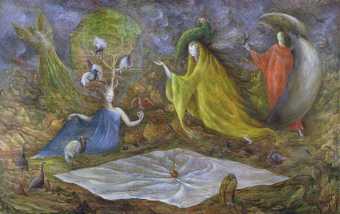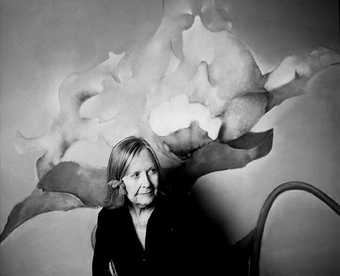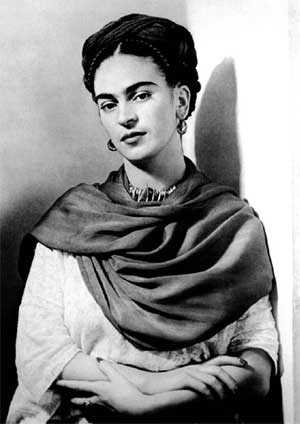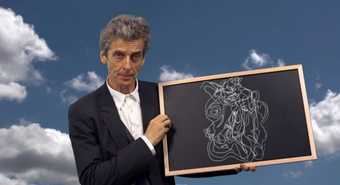
Leonora Carrington The Pomps of the Subsoil 1947 © ARS, NY and DACS, London 2014
When most people think of surrealism, men such as Salvador Dali, Rene Magritte, Joan Miro, Marcel Duchamp, Giorgio de Chirico and Man Ray, spring to mind. It’s hard not to notice the lack of female names. We celebrate the women whose work has gained the recognition it deserves.
Leonora Carrington and Max Ernst
Leonora Carrington, began her career as the plus one of famous surrealist Max Ernst. It is easy to become acquainted with the story of Carrington’s life. The events would make a brilliant film - her sheltered youth, the elopement with an older man, the onset of war followed by a mental breakdown, a second elopement and finally settling down in Mexico. Her life is documented as a whirlwind of romance, pain, danger and drama.
In 1948, Time Magazine reviewed an exhibition of her work:
The walls … were hopping with demons. Feathery, hairy, horny, half-luminous creatures merged imperceptibly into birds, animals and plants. Painted with cobweb delicacy, they conspired and paraded before misty landscapes and night skies thick with floating islands. All the pictures had two things in common: an overall melancholy and the signature, Leonora Carrington …
This is an apt description of the hallucinatory world of Carrington’s paintings. When asked about the meaning behind her work, she said:
You’re trying to intellectualise something, desperately and you’re wasting you’re time. That’s not a way of understanding… [you can only understand] by your own feelings.
‘Leonora Carrington: Britain’s Lost Surrealist’, The Guardian, 2010
This response is more purely surrealist than any of the Freudian symbols or mythological references appropriated by her male counterparts. As Andre Breton wrote in his text Arcane 17, woman is a natural ‘conductor of mental electricity’. Likewise Carrington wants us to feel, not to think, and through feeling, tap into the unconscious and intuitive mind.
Dorothea Tanning and Max Ernst

Dorothea Tanning in front of her 1998 painting Quiet-Willow Walk
Photograph by Steve Moss
Although his relationship with Carrington has been greatly romanticised, Max Ernst’s most successful and long-lasting relationship was with Dorothea Tanning. Here, Tanning explains her views on marriage and equality:
If you get married you’re branded. We could have gone on, Max and I, all our lives without the tag. I never heard him use the word “wife” in regard to me. He was very sorry about that wife thing. I’m very much against the arrangement of procreation, at least for humans. If I could have designed it, it would be a tossup who gets pregnant, the man or woman. Boy, that would end rape for one thing.
Dorothea Tanning, Between Lives: An Artist and Her World, 2003
Tanning’s early paintings often feature female, or simply feminine, characters in minutely detailed gothic and dream-like settings. The regular use of the female form throughout surrealist work has been an interesting playground for debate. Numerous critics, such as Susan Gubar, have argued that the surrealist’s appropriation of the female form in works such as Rene Magritte’s Le Viol can be seen as an aggressive objectification of women. Others, such as Germaine Greer, take this argument further, debating whether the female members of the group had internalised this viewpoint and perpetrated it in their own work.
Tanning’s sculptural piece Nue Couchee has also often been interpreted as a comment on female sexuality due to its limb-like protuberances and nude pink fabric, however she strongly rejects any association to gender. Neither does she want to be analysed in terms of her femininity and labelled in the category of ‘woman artist’:
I wish you wouldn’t harp on that word, ‘women.’ Women artists. There is no such thing – or person. It’s just as much a contradiction in terms as ‘man artist’ or ‘elephant artist.’ You may be a woman and you may be an artist; but the one is a given and the other is you.
Carlo McCormick, ‘Dorothea Tanning’, Bomb Magazine, 1990
Frida Kahlo and Diego Rivera

Nickolas Muray Frida Kahlo 1941 © Nickolas Muray Photo Archives
Frida Kahlo is certainly no longer seen as the woman behind Diego Rivera, but at the time his fame was overshadowing. These days she has been appropriated as a feminist forerunner, stoic sufferer, Mexican national heirloom and one of the ‘Great Surrealist Artists’. People worldwide have been enchanted by her frank, intense and honest letters which give an insight into her character and opinions. The director of the Bellas Artes Museum, Roxana Velasquez Martinez del Campo, described her as ‘a woman in constant expression’ and this is what we see when we look at her self-portraits. They are instinctive depictions of her subconscious with repeated references to her physical and emotional pain:
I paint my own reality. The only thing I know is that I paint because I need to, and I paint whatever passes through my head without any other consideration.
Harry N. Abrams, Discoveries: Frida Kahlo Painting Her Own Reality, 2008
It is this openness, which makes her remarkable and has caused so many people to respect and admire her.
Despite their rocky relationship, Kahlo’s love for Diego was insurmountable. In this explanation of her opinion of marriage, we see her fatalistic approach:
I don’t believe in marriage. I think at worst it’s a hostile political act, a way for small-minded men to keep women in the house and out of the way, wrapped up in the guise of traditions and conservative religious nonsense. At best, it’s a happy delusion – these two people who truly love each other and have no idea how truly miserable they’re about to make each other. But, but, when two people know that, and they decide with eyes wide open to face each other and get married anyway, then I don’t think it’s conservative or delusional. I think it’s radical and courageous and very romantic.
Julie Taymor, Frida, 2002

Frida Kahlo The Love-Embrace of the Universe 1949 Cultural Morelos Foundation (Muros) and Costco/Comercial Mexicana © Banco de México and INBAL Mexico, 2005
Kahlo’s passion for Diego may have caused her pain, but she was never subdued by it and in many ways this passion contributed to her becoming the powerful figure she is now.
Carrington, Tanning and Kahlo are by no means the only surrealist artists who were once seen as secondary to their partners. Photographer Lee Miller was the lover of Man Ray and artist and writer Unica Zurn was the partner of Hans Bellmer … The list goes on. Robert J. Belton contextualises this pattern:
The women who did speak up during that particular monologue [of Surrealism] were drowned out by male voices because their historical moment… had not yet come.
Robert J. Belton, Speaking with Forked Tongues: ‘Male’ Discourse in ‘Female’ Surrealism, 1990
Perhaps, now, their time has finally arrived.


